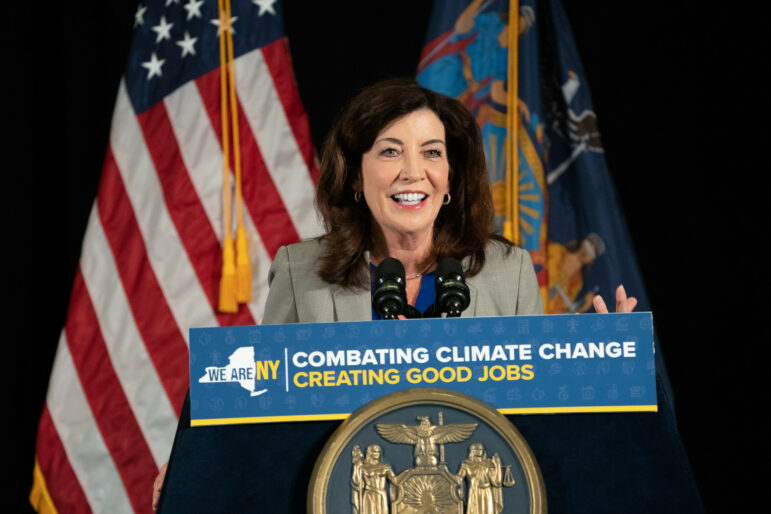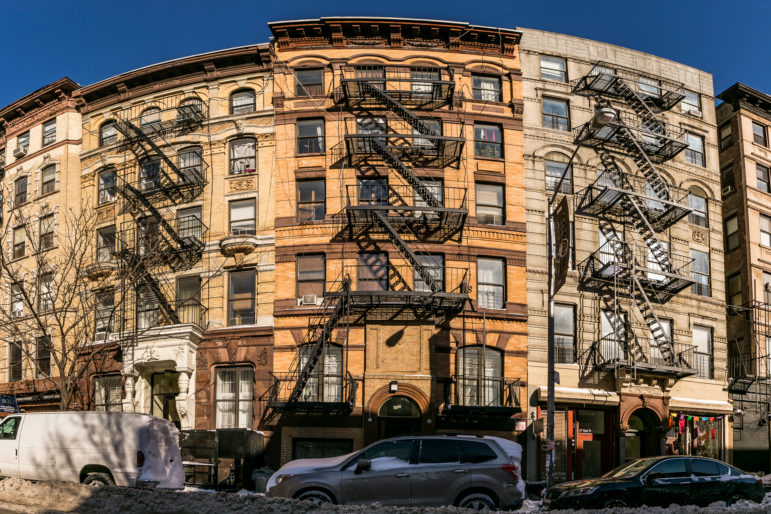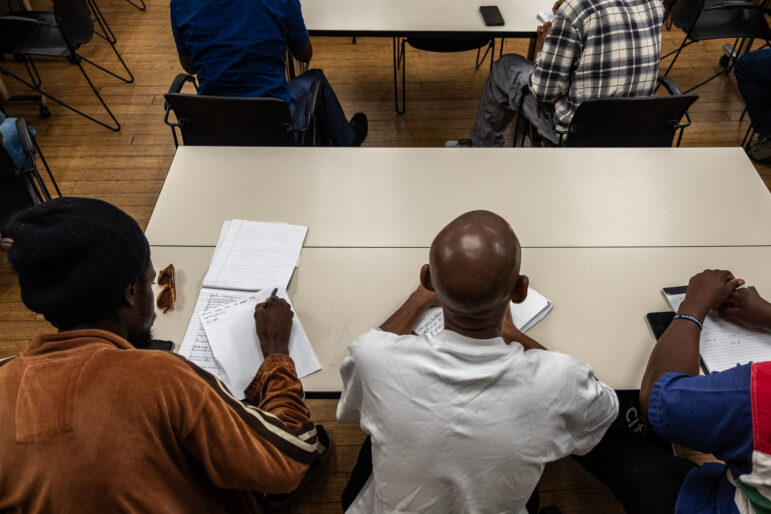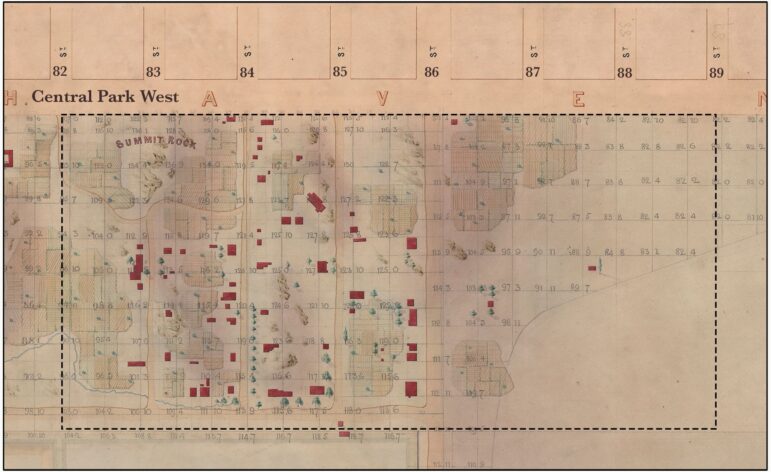
Adi Talwar
The line outside 26 Federal Plaza one recent morning. It is one of two locations in the city where immigration hearings are held.
This is the final part of a five-story series on the policy problems and human dramas that characterize immigration court in the New York City area. Be sure to check out the rest of the series.
* * *
Immigration court is open to the public. At Federal Plaza, after showing your state-issued ID at the door and passing through metal detectors where you submit your shoes, watch, and computer for inspection, you can take the elevator to the 12th or 14th floor and walk into any courtroom to observe the proceedings, which range from asylum hearings to the “Master Calendar”— a short, preliminary hearing, usually the beginning of efforts to remove an immigrant from the United States, where the immigrant meets with the judge and the government attorney to figure out how their case will proceed.
The courtrooms are small, intimate even, with maroon carpets, wooden tables for the lawyers, and only a few pews for spectators, in the back behind a wooden gate. The government’s lawyer, an agent of ICE, takes the elevator down from the agency’s offices with a metal cart full of charts. They will stay with the judge all day. Though the system is adversarial, the feeling between lawyers is rather calm, almost collegial at times. The judges, government attorneys, and immigrants’ lawyers all seem to be battling the docket more than each other.
The “respondent,” as the immigrant is called sits very close to the judge. He or she is referred to by the last three numbers of their alien number, or if they have a lawyer, by the lawyer’s name. The judge calls immigrants with lawyers first, and then immigrants without lawyers. Some judges seem bored, while some are cajoling, like a teacher or an aunt. The low murmur of the interpreter is constant, their intonation rising and falling with the intonation of whoever is being translated.
Judge Amena Kahn was presiding over the master calendar for the unaccompanied docket—those of the 70,000 children, mostly from El Salvador and Guatemala, who had entered the U.S. without their parents and ended up in New York.
Out in the hallways, large groups of minors and their guardians who didn’t fit into the courtroom would congregate, about 50 when it was the most crowded. It was the quietest crowd I had ever been in. Most of the unaccompanied minors were teenagers—young men from Honduras and El Salvador with slicked black hair and pimples and gold chains, and girls with bright pink tops and pink barrettes in their long silky black hair, who had crossed into the U.S. alone and were now in court beside the parent with whom they had been reunited. No one was smiling or joking. There was a weight hanging over the room. Sometimes the guardian or parent looked hardly older than the unaccompanied minor. Others seemed to hardly know the person they were with.
One boy spoke only a Mayan dialect called K’iche’. He was brought into the United States by relatives, then passed along to other relatives, and now he was being represented by a “friend,” who, when the judge asked, didn’t know the boy’s address. He did know that the boy was not currently enrolled in school, which was important. Kahn would waive the child’s presence in court if they could produce proof of enrollment. “Do well in school,” she told each of the children at the end of their hearing.
Out in the hallway, no one wanted to tell me about the journey that brought them to this country. There seemed to be a level of shame associated with the arduous trip.
“How did you get here?” I asked an Ecuadoran man with a thick mustache and white shirt who had come to the U.S. first and then sent for his teenage son, who was sitting beside him in the waiting room.
“Like everyone else,” he said, gesturing wearily around the room.
“What are you hoping for in court today?” I asked through my translator.
“Whatever we can get,” was all he would say.
On another day in a different hallway, a young girl stood with her mother who has been living in the United States for many years. The girl had stayed behind in El Salvador with her grandmother, but a gang had started threatening the family, demanding what the girl’s mother called “rent”—to the tune of $3,000 at a time. The mother could no longer pay it, and she decided it was time to send for her daughter, who made the trip two months ago.
The mother was happy to talk, but the girl hid behind her mother’s shoulder with a shy smile. “The river was the hardest part,” she whispered when asked about her entry. Seventy people drown each year trying to cross the Rio Grande—a popular crossing point on the U.S.-Mexico border. I asked the girl what she hoped for her life in the United States. “I want to be someone,” she admitted softly.
Sebastian—the young man who fled Guatemala—had crept in through the border but hadn’t been detained; his leader or “coyote” had known a border patrol officer, who Sebastian says he paid off. He was in court to lend moral support to a friend, a 15-year-old girl who held a folder with her documents up in front of her face when I asked her to tell me about her trip. While we spoke, another young girl came down the hall accompanied by two older men. When the two girls saw each other, they cried out and embraced. They had made the crossing together, and they clung to each other in the hallway.
When an unaccompanied child not from Mexico arrives in the U.S., they first are apprehended by the Border Patrol. They are then turned over to the Office of Refugee Resettlement in HHS, which houses them in more humane facilities, and seeks to release them to sponsors, generally family or family friends, to await proceedings. Children from Mexico—a “contiguous state”—are screened by DHS to determine if the child is a victim of trafficking or has a claim to asylum based on fear of persecution. If neither of these is the case, they are eligible for “speedy repatriation” back to Mexico.
If one of their parents has status, the child has a strong immigration case, and many believe that the majority of the 70,000 children from the surge docket that Obama planned to expedite out of this country are reuniting with parents and will end up with strong cases to stay.
Toddlers face the same process as adults in U.S. immigration court, with no guaranteed right to counsel. As a person specializing in immigration in a D.C. think tank put it, “imagine you are 4, don’t speak the language, are in immigration court, and have a trained government attorney seeking to deport you. Do you really have a chance?”
One little girl, a 12-year-old from El Salvador, was put in charge of bringing her older sister to Federal Plaza because the little girl had been through the courts the year before and knew the routine. She told me in good English acquired in just a year that she came to the U.S. with a “leader.” There were five people in her group who took a bus to the U.S. border and then walked through the desert. It took fifteen days, and there wasn’t always enough to eat. “It was eggs, eggs, eggs,” she remembered, screwing up her nose. She still worries that she might be sent back to El Salvador. “There are so many people who are bad,” she told me. “They kill people.” Her cousin had been murdered by a gang just before the family decided to make the journey.
Whose danger makes them deserving?
At Federal Plaza, you can also observe asylum hearings, as long as there is no sensitive information and neither lawyer objects to your presence. My first day in the courts, a middle-aged woman who was an ethnic Russian from Kazakhstan had applied for asylum, claiming that she would be persecuted if she returned to her home country.
“The respondent has failed to show evidence of persecution,” Judge James Loprest concluded. Nevertheless, he granted her asylum, and told her she could apply for a green card and then citizenship.
The woman was delighted. “Thank you very much,” she said with a huge smile. “Thank you very much. Thank you. My whole church is waiting for me to hear how it went.”
“I don’t like to say congratulations in asylum cases—I feel it’s not appropriate,” the judge said. “But welcome to the United States.”
A few weeks later, I observed a Chinese woman applying for asylum because she belonged to the Chinese Democracy Party—an organization with the stated aim of overthrowing the Chinese government. The woman claimed her membership in this party would cause her to be persecuted and arrested if she returned to China. The government lawyer cast aspersions on this idea, and asked for evidence that anyone belonging to the CDP had been arrested. “The Chairman of the CDP told me they were,” the woman said through a translator. The woman also claimed that she had written an article about police brutality on the CDP’s website and that the Chinese government had read it.
“Were you ever the object of police brutality?” The government lawyer asked through the translator.
“No.”
“Was anyone in your family?”
“No.”
“Then how did you find out about it?”
“From friends at a dinner party,” the woman answered.
“How do you know these friends?”
“I have my friends, you have yours!” She answered heatedly.
At the end of the questioning, the judge, Frederic Leeds, decided that the respondent had provided a plausible explanation that was “generally consistent.”
“Asylum is going to be granted,” he concluded.
The third rail
Sebastian, the young man from Guatemala, lives an undocumented life. If he stays out of trouble and doesn’t get arrested, he can continue to live in the shadows here. He will never be able to see his parents, who remain in Guatemala, or to travel, and any brush with the law—even a traffic violation—can put him on ICE’s radar. But the likelihood that he will be physically deported seems slim. Anecdotally, most of the lawyers I spoke to told me that every single client they have ever represented whose asylum case was denied is still living in the U.S. “That’s why it’s such a sham,” I was told, over and over.
“Our national dialogue on immigration has been warped by inaccurate and harmful themes of criminality and lax border enforcement and terrorism, when in fact that’s really not what immigration policy is all about,” Peter Markowitz of Cardozo explained. “Immigration policy is about democracy, self-identity, economic vitality, and family. And the president has really missed an opportunity to set us on the right track as a nation on immigration by refusing to take head on the fallacy of the immigrant as criminal.”
Those who lose their asylum cases—50 percent nationwide in 2013 – can appeal their claim. Most people who apply for asylum also apply at the same time for other immigration statuses, like “withholding of removal” and protections under the convention against torture at the same time. Even if they don’t meet the higher standards for asylum, they might qualify for one of the other statuses and still get to stay. They are also given the option of “voluntary departure” in which they chose to be deported so they don’t face the three- to 10-year prohibition on re-entry that other deportees face, in case they want to try to come again, by legal or other means.
It presents a complicated set of choices for immigrants, one more reason why having a lawyer is essential. Under the City Council-funded New York Immigrant Family Unity Project (NYIFUP), which gives nonprofit law firms money to represent immigrants who can’t afford a lawyer, more New York immigrants facing immigration court hearings now have counsel.
Even Wen-Ting Cheng of ICE approves of the NYIFUP program. “The representation program has been good in terms of making sure that people’s due process have their to make sure that someone who is knowledgeable about the law ferret them through the system,” she told me.
“We know we’re dealing with people’s lives and we’re just looking for a just result,” she explained. “When we speak to our staff about their performance, we don’t measure success in terms of wins and losses. We want to see cases brought to completion in an efficient and an effective manner that serves justice. We don’t track statistics for individual attorneys based on wins and losses.”
But even its most ardent champions acknowledge that NYIFUP is a band-aid on a national bullet wound, a way to increase the fairness for immigrants in a dysfunctional system. But the likelihood that an honest national conversation will take place—and that humane and sensible immigration policy will come out of it—looks less and less likely as time goes on. As one judge who requested anonymity put it, “immigration is the third rail of politics.” With elected leaders unwilling to touch it, its left to the immigration courts, and the lawyers and judges who work there, to try to wring justice out of the system’s flawed fabric.
“There should be a conversation about what we are doing and who we are protecting, as opposed to lawyers just litigating this issue,” says Dzubow. “This is an area where we’re deciding who we’re letting into our country. It’s an area that impacts foreign policy. Without a conversation and just relying on litigation to let this happen—it’s just disappointing.”
City Limits is grateful to the readers who donated to create this project along with the generous underwriting of Beacon.
* * *








